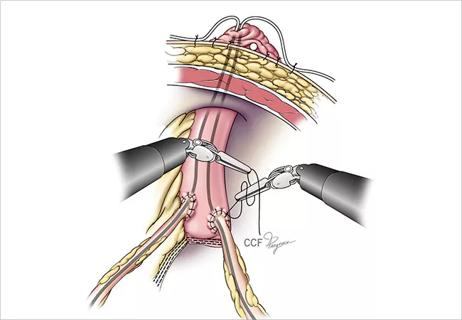
Arthur D. Steffee, MD, and Louis Keppler, MD, first met in 1978 as teacher and student. Dr. Steffee was on staff at St. Vincent Charity Hospital in Cleveland, and Dr. Keppler was a resident at Cleveland Clinic, just as Dr. Steffee had been years before.
Advertisement
Cleveland Clinic is a non-profit academic medical center. Advertising on our site helps support our mission. We do not endorse non-Cleveland Clinic products or services. Policy
“I first got to know Art as an intern, and then I came back as a junior resident, and we hit it off well,” Dr. Keppler (ORS’83) recalls. “It was a great experience. In 1983, I was Chief Resident, and we were doing total joint surgery and spinal surgery together there.”
At that time, Dr. Steffee (GL-1’61, S’62, ORS’67) was developing a revolutionary pedicle screw system to stabilize the spine with surgery. Later in 1983, after Dr. Keppler had a fellowship at the Texas Scottish Rite Hospital for Children in Dallas, he arranged for Dr. Steffee to speak there. Dr. Steffee’s presentation stunned the international audience of spine surgeons and launched him onto the world stage. From then on, his game-changing innovation “rolled like a canon,” says Dr. Steffee, who today is known as the father of modern spine surgery.
Dr. Steffee regards the Dallas lecture not only as a turning point in his career, but also in his relationship with Dr. Keppler. When Dr. Keppler returned to Cleveland in 1986, Dr. Steffee and his partner Karl Alfred, MD, hired him as their partner. Their continuing collaboration transformed their lives and the lives of patients around the globe.
The dawn of the pedicle screw
The year before his talk, Dr. Steffee was faced with a problem. “As I operated on a patient’s back in 1982, I took away so much bone, and I needed to pass a wire around the vertebrae to stabilize the spine. At that time, all we had was the Luque System, with which we needed to have the laminae so we could pass a wire under it and around a rod to stabilize that particular vertebra. Well, I’d taken all that out. My nurse Patricia, who I later married and was my wife for over 20 years, said, ‘Why don’t you just take one of these bone screws and put it down that pedicle with a washer on it and wire it to that?’ It worked so well that when the next case came along, I said, ‘Well, let’s do it again.’ That’s how it all started. A problem presented itself, and we fixed the problem on the spot. You don’t sit around a table and think, ‘What am I gonna’ do?’ You find a solution. It all just unfurled. I certainly do give Patricia the credit.”
Advertisement
He continued modifying this approach with the help of his then-resident Dr. Keppler. “At that time, we were putting screws into the pedicle but hooking them up to wires, like a trucker’s hitch, and connecting those wires to rods in patients that had previous surgeries,” Dr. Keppler says. “One lady had a spinal condition, and I thought that the screws would help. We put them through a plate rather than a rod. She looked great on the operating room table, but as soon as she stood up, the instrumentation didn’t hold. Dr. Steffee said, ‘All we need to do is to put in more screws first and then put the plates on.’ We had some stainless-steel nuts for another pin system and took the screws to the machine shop at St. Vincent’s, where they were modified to fix the thread of the nuts. They also cut some slots in the plate. So, in 1983, we created the first spine plate surgery with pedicle screws.”
That year, after his talk in Dallas, Dr. Steffee founded AcroMed to produce spinal implants, as well as artificial vertebrae and discs he developed. “I also put in five artificial sacrums,” he says. “We had a complete laboratory and machine shop at Charity Hospital where we could build things instantly. Our machinist, Frank Jansen, who was Polish and had been a Spitfire pilot in the Battle of Britain, could build or modify anything we could think of.”
Dr. Steffee and Patricia traveled throughout the world for the company, performing operations in 35 countries. “I would say to the people arranging the cases, ‘I don’t come without Patricia,’ because the scrub nurses in other countries didn’t speak English, and they had to know and understand what to do in this new procedure,” Dr. Steffee says. “I couldn’t have existed without her. She was always at my side. The two of us knew exactly what we were doing all the time. We were a team.”
Advertisement
When Dr. Keppler became Dr. Steffee’s partner, he took care of patients in Cleveland while Dr. Steffee traveled. “I stayed home and went to work,” he says. He notes that Cleveland Clinic residents still visited them, and in a year, so did about 150 to 200 surgeons from all over the world, who came to Cleveland to learn the pedicle screw technique.
Dr. Steffee retired in 1997. Several other Cleveland Clinic surgeons have practiced since then with Dr. Keppler, who also was the physician to the Cleveland Indians from 1991-2006 and now sees patients at Southwest General Health Center. He also started a company to further investigate another innovation by Dr. Steffee, carbon-composite implants for orthopaedic and spinal surgery.
“I am most proud of being able to care for patients and still being able to practice medicine in a way where patients come first,” Dr. Keppler says. “I learned from Art, and from Lester Borden (ORS’05), Jack Andrish (TRS’70, S’71, ORS’76), Alan Wild (ORS’91), Bernie Stulberg (ORS’80), and Alan Gurd (ORS’76). And also from John Bergfeld (TRS’65, S’67, ORS’70), who is most responsible for my interest in sports medicine. I couldn’t have been happier with the mentors I had as a resident at Cleveland Clinic and with my training. It was truly exceptional.”
Of Dr. Steffee’s innovation, Dr. Keppler says, “It’s the standard of care now. He changed the way spinal surgery is done throughout the entire world.”
Ed Benzel, MD (Staff’99), Emeritus Chair of Cleveland Clinic’s Department of Neurosurgery, agrees. “Art Steffee is a giant in the field of spine surgery,” Dr. Benzel says. “His courage, insight, and immense foundation of knowledge forged the way for him to advance the field in its primal years via innovation, political savvy and fortitude. It is without question that he singlehandedly ushered in the modern era of spine surgery.”
Advertisement
In recognition of his achievements, each year, Cleveland Clinic’s Neurological Institute honors Dr. Steffee through its Spinal Review Course that includes a guest lecture named for him and which provides an opportunity to share new ideas, much like the venue that launched Dr. Steffee’s career. In 2022, Serena S. Hu, MD, of Stanford University School of Medicine, the first woman President of the American Orthopaedic Association, was welcomed as the Art Steffee Honored Guest Lecturer.
Retiring – and buying a town
After retiring, Dr. Steffee and his wife, Patricia, took on a new project: Buying and rebuilding the town of Foxburg, Pennsylvania, near Oil City, where he was born and raised. At that time, the tiny town had only one restaurant, which Dr. Steffee describes as “a greasy spoon with a mud lot. But here was this beautiful valley, with a river running through it, and I said, ‘This is my home now.’” He and Patricia resurrected Foxburg by opening a restaurant, a winery, an arts center and a 24-room hotel. They also remodeled buildings that now feature retail businesses and capitalize on the waterfront setting, and they donated land to create a biking trail.
The Steffees’ main goal was to refurbish the Fox family estate, important to the early Quaker movement. By 1998, when the Steffees became involved, it needed significant restoration. “But the land was good, with 1,200 acres surrounded by the Clarion and Allegheny rivers,” Dr. Steffee says. The estate, which he rebuilt, was their home until Patricia passed away in 2018. He sold the house and town to Cleveland entrepreneur Saji Daniel. Dr. Keppler helps maintain the estate. “I’m MD at the farm, but ‘MD’ stands for ‘maintenance director,” Dr. Keppler says. Following Patricia’s death, Dr. Steffee met and married the buyer of another home he had rebuilt, Marybeth, and they live there together.
Advertisement
At the age of 88, Dr. Steffee still enjoys maintaining the Fox estate, where he currently is remodeling a mountaintop. “I’m building a hill for sledding that will be 1,700 feet long with a 244-foot drop,” he says while sitting atop an excavator. He also maintains his health – and he has benefited from his own inventions.
“Five years ago, I had to have those same plates and screws put into my own back,” he says. “I dug around in my old travel kit and found some of the type that we used when we traveled the world, and I took ’em over to Lou Keppler and said, ‘Here, cook ’em up and put ’em in.’ I was only in the hospital one day, and I’ve never taken a pain pill since that operation. So, I know they work. If you have the right indication and do the right operation, you can win, and the part we fix will last a lifetime.”
Advertisement

Study shows surgical experience impacts the risk of post-operative stricture formation

Study offers evidence to guide treatment decisions

Assessments of the shorter collection routine are encouraging, but not yet definitive